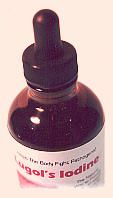|
Product Identification |
| Manufacturer's Name & Address: |
Herbologics, Ltd.
8345 NW 66th St., #7093
Miami, FL 33166-2626
Phone:
1-305-851-2308
Fax: (888) 450-7909 |
|
|
|
|
|
|
|
|
|
Product Name: |
Lugol's Iodine |
|
| Product
Code: |
565 |
|
| Product
Description: |
A aqueous
solution of iodine and potassium iodide in
water. | |
| Health |
2 |
| Flammability |
0 |
| Reactivity |
1 |
| Physical
Hazard |
None |
|
| Section
1 - Shipping Data |
| DOT Shipping Name:* |
Not applicable |
Tel. # for information:
|
(305) 851-2308 |
| DOT Hazard Class: |
Not applicable |
Prepared by: |
J.C. |
| DOT
Identification: |
Unregulated |
|
| |
| Section 2 - Hazardous
Ingredients / Identity Information |
|
| CHEMICAL
COMPONENTS |
CAS# |
% |
OSHA PEL |
ACGIH TLV |
| iodine |
7553-56-2 |
5.0% w/v |
1.0 mg/m3 TWA ceiling |
1.0 mg/m3 TWA ceiling |
| potassium
iodide |
7681-11-0 |
10.0% w/v |
------ |
------ |
 Questions have arisen concerning the purity and source of
the raw materials used in our Lugol's. Both iodine ingredients
are USP (pharmaceutical grade). The potassium iodine is
made by Amphray (see MSDS -- also
the Certificates of Analysis for the last two batches used:
P25407 and
P25309) and
the iodine crystal is made by Malinckrodt
(see MSDS), inventory
# Baker 2211, 99.8% pure, USP.
Questions have arisen concerning the purity and source of
the raw materials used in our Lugol's. Both iodine ingredients
are USP (pharmaceutical grade). The potassium iodine is
made by Amphray (see MSDS -- also
the Certificates of Analysis for the last two batches used:
P25407 and
P25309) and
the iodine crystal is made by Malinckrodt
(see MSDS), inventory
# Baker 2211, 99.8% pure, USP.
| |
|
Section 3 -
Physical / Chemical Characteristics |
| Boiling Point: |
101� C |
Specific Gravity (H20 =
1): |
1.1 |
| Vapor Pressure (mm Hg and
Temperature): |
18 @ 20� C |
Evaporation Rate ( n-butyl alcohol=
1): |
1 |
| Vapor Density (AIR=1): |
0.6 |
Solubility in Water: |
100% |
| Appearance and Odor: An opaque
purple solution with the characteristic odor of
iodine. | |
| Section
4 - Fire and Explosion Hazard Data |
| Flash Point (Method Used): Not applicable |
Flammability Limits:
Not applicable |
| Extinguishing Media: Not
applicable |
| Special Fire Fighting
Procedures: Not
applicable |
| Unusual Fire and Explosive
Hazards: Pyrolysis will release
corrosive iodine vapor. | |
|
Section 5 - Reactivity Data |
| Stability:
Stable |
Conditions to Avoid:Heat |
| Incompatibility (Materials to
Avoid):
Nothing unusual. |
| Precautions to be taken in Handling and
Storage: Store at room
temperature. | |
|
Section 6 - Health Hazard Data |
| Routes of Entry |
Inhalation? |
Skin
Absorption? |
Ingestion? |
| |
yes |
yes |
yes |
|
Carcinogenicity? |
NTP? |
IARC
Monographs? |
OSHA
Regulated? |
|
no |
no |
no |
no |
| Health Hazards (Acute and
Chronic): Large doses of iodine cause sever vomiting,
diarrhea, abdominal pain, thirst, shock, fever, delirium, stupor and
death. Prolonged exposure to iodine compounds may produce iodism and
deficiency of thyroid hormone. |
| Signs and Symptoms of
Exposure: May cause
contact dermatitis. Repeated, excessive
exposure to iodine compounds may cause
rash, swelling of the vocal cords, severe generalized allergic
reaction, joint pain and swelling. Iodine is absorbed through intact
skin. |
| Medical Conditions Generally Aggravated by
Exposure: Individuals with thyroid, lung or kidney disease may wish to
consult a physician before working with iodine
compounds. |
Emergency and First Aid
Procedures:
Seek medical assistance for further treatment,
observation and support if necessary.
Eye Contact:
Flush with water at least 15 minutes and get medical
attention if irritation persists.
Skin
contact: If exposed to more than five drops,
remove contaminated clothing
and flush with water. Get medical attention if irritation
persists.
Ingestion:
If four drops or more are ingested at one time,
immediate steps should be taken. Do not induce vomiting if patient is
unconscious or extremely drowsy. Otherwise administer 2 glasses of
water and induce vomiting. Get immediate medical attention even if
symptoms improve.
| |
| Section
7 - Precautions For Safe Handling and Use |
| Steps to be Taken In Case of Spill Or
Release: Absorb
with a suitable absorbent (such as a paper towel) and
dispose. |
| Waste Disposal Methods:
Usually not restricted,
but local ordinances vary. Iodine may often be
neutralized with thiosulfate and flushed down drain with excess
water. Insure compliance with all government regulations.
| |
| Section
8- Control Measures |
| Respiratory Protection (Specify
Type): Not
required. |
| Ventilation:
General ventilation is usually
sufficient. |
Protective Gloves: Not
required.
|
| Eye
Protection: Not required
but laboratory safety goggles or similar products are recommended as
part of good laboratory practice. |
| Other Protective Clothing And
Equipment: Not
required. |
| Hygienic Work Practices:
Wash well after handling, especially before eating and
smoking. | |
 LUGOL'S IODINE
LUGOL'S IODINE